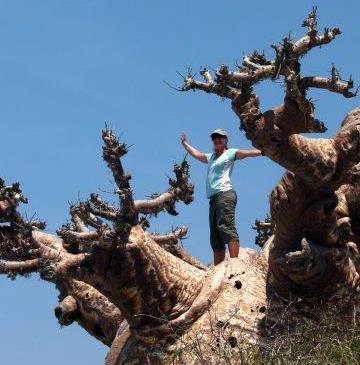By Karen Toque, Blue Ventures volunteer, Madagascar
It was time for a break from diving to allow the nitrogen bubbles that had built up in our blood over the past five days spent underwater to leave the body. We decided to head off to the baobab forest, which is about a 5km walk from Andavadoaka village and takes around 90 minutes to walk along the sandy tracks. The best plan is to leave as early as possible as it gets incredibly hot in the forest.
The baobabs are very old trees with vast trunks used as storage for water. The baobabs in this forest are about 4m high with spindly little branches reaching out from the trunk. The first baobab that we came to looked like it was painted; seemingly decorated with concentric circles of white, ochre and a purplish hue. The locals had cut foot holds into the trunks so that they could climb the trees to get at the fruit which they say is fantastic but unfortunately it is not the right time of year for us to get a taste. I climbed the baobab (knew my indoor rock climbing would come in handy one day) and could see on top of the trunk a perfect platform from which you would have fantastic panoramic views of the surrounding spiny forest.
Climbing down was a little trickier than going up and as I put my hand into a hollow I heard a rustle of quills – my fellow explorers were impressed that I managed to stay in the tree as I jumped so high. When my heart stopped pounding, and I got my breathe back from the scare, I looked into the hollow and came face to face with a pair of yellow eyes and a very upset Madagascar Scops Owl, Otus rutilus, sitting on a nest with a couple of little white eggs. The owl was 22-24cm with brown colouration and amazingly camouflaged – if she hadn’t rattled her quills, I would not have known she was there. I got back to the ground and borrowed a point and press camera (a SLR is a little awkward to use one handed up a tree) and captured the little owl for everyone to see.
We continued on our exploration of the baobabs and found the nest of a Greater Vassa Parrot, Coracopsis vasa, whose plumage is black but when the female is mating and has a chick to feed, she sheds the feathers on her head to show the red skin below.
There was one baobab with a large cavity in its trunk vast enough to comfortably fit 10 people inside. The biggest baobab must have been about 12m across and takes at least 18 people joining hands to reach around the trunk!
We also spotted a lot of the spiny forest birds such as the Madagascar Bee-eater, Merops superciliosus, which has beautiful glossy green colouration and swoops down to catch bugs on the wing; and the Madagascar Hoopoe, Upupa epops marginata, a beautiful bird with rufous feathers and black wings with white spots that are stunning in flight. The Hoopoe has a prominent crest which they use to communicate with other Hoopoes.
The visit to the baobabs was definitely worth the trip and a pleasant change from the seascape.



